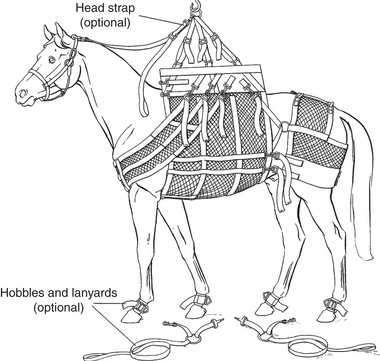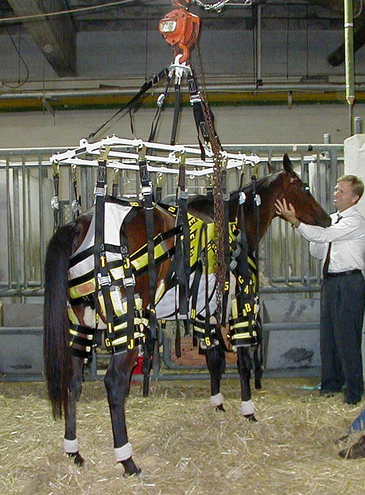CHAPTER 202 Maintenance of Horses in Slings
Equine full-body support slings may be useful when caring for horses that are unable or unwilling to stand or support full or partial weight on one or more limbs as a consequence of neurologic or musculoskeletal disorders. Equine full-body support slings should be considered an adjunct to medical or surgical interventions. Although the sling may provide a useful and practical means of supporting and caring for disabled horses, it must be used with great care by trained personnel because many horses do not tolerate its use. In such a situation, attempts to sling a horse may cause injury or harm to the handlers or further injury to the equine patient. Case selection and conscientious patient management are critical for a positive outcome when considering the use of the equine full-body sling as part of a patient management protocol.
TYPES OF SLINGS
Various sling types can be used to provide full-body support for a horse. The same principle is applied in all types, wherein weight bearing is distributed from a central point to predominantly the abdomen and caudal thorax-sternum. Variations of slings include chest or breast components as well as tail pieces that fit below the tuber ischii. In addition, some limb supports can be added to minimize the weight borne by the abdomen and sternum alone. Two types of commercial sling types are available and commonly used throughout the United States and elsewhere. The Liftex (Liftex Corporation, Warminster, PA) large-animal sling is a three-piece unit (Figure 202-1) that includes a central abdominal piece and incorporates a chest and tail piece. This sling is suspended from a single central point. Its advantage is its ease of use, even in recumbent animals, because it has only three main parts with the breast piece and rump piece each attaching to the central thorax-abdomen support piece. Attachments are available if there is a need to support the head in compromised horses.
The University of California (UC) Davis Anderson Sling (Care for Disabled Animals [CDA] Products, Potter Valley, CA) has greater versatility than the Liftex sling because it includes numerous adjustment sites that make it useful for most situations in which horses require support. The Anderson sling is suspended from a metal frame that hangs from a central point (Figures 202-2). It enables a broader distribution of weight by the addition of limb support components that reduce the force applied to the abdomen, chest, and rump-tail pieces. This makes it better for horses that need long-term support because it reduces the number of pressure sores and skin abrasions. In addition, there is a head restraint piece that provides head and neck support, which is particularly useful when working with a horse that has difficulty holding its head up or during helicopter rescue operations. The Anderson sling has been used successfully in equine search-and-rescue operations.
CLINICAL INDICATIONS
Musculoskeletal Problems
Occasionally it may even be optimal to conduct a surgical procedure with the horse maintained under anesthesia within a sling to avoid the respiratory compromise that can occur during prolonged periods of dorsal or lateral recumbency. The alternative to slinging the horse is to keep it in sternal recumbency, but prolonged sternal recumbency can result in post anesthetic lameness, especially if the limbs are tucked underneath the body. The disadvantage of keeping the anesthetized horse in the sling is compromised access to the surgical site.
Stay updated, free articles. Join our Telegram channel

Full access? Get Clinical Tree




